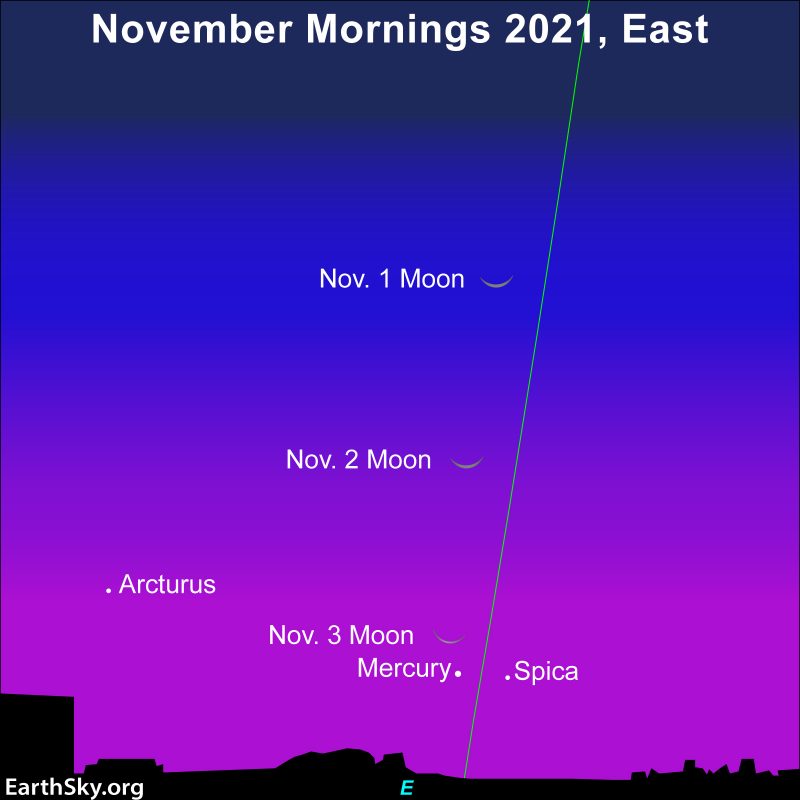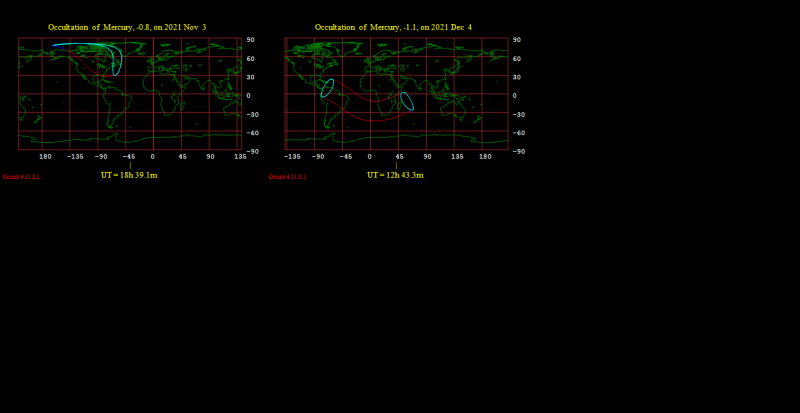
Moon and Mercury: beauties!
Mercury, the smallest planet and innermost to the sun, is now wrapping up a string of morning appearances that began in mid-October. Early risers can still spot it above the sunrise point in late October and during the first few days of November. At that time of the morning, it’ll be in brightest twilight, near the not-yet-risen sun. Mercury is sometimes difficult to identify. But, for Northern Hemisphere observers, the mornings of November 1, 2 and 3, 2021, provide a good opportunity for positively spotting the planet near the waning crescent moon, or “old” moon. The steep autumn angle of the ecliptic for us in this hemisphere will enhance the view. Look near the horizon for the thin crescent. Mercury will be the point of light just below it.
Here is a great way to start your day: Break out the binoculars to spot the little world and to examine the earthshine on the moon’s dark side.
Because of the tilt of the ecliptic, Southern Hemisphere viewers unfortunately won’t have a good view of Mercury or the moon on the November 3, or at any time during the October-November morning apparition of Mercury.
Daylight occultation of Mercury
The moon will occult, or cover over Mercury, on November 3, 2021. The occultation will be visible from most of Canada and the northeastern United States. But it will be in daylight. This will be a challenging observation, and only veteran observers, with telescopes or other optical aid, will attempt it. A very clear sky will be essential!

Bottom line: The old moon will sweep near Mercury on the mornings of November 2 and 3, 2021. From Canada and the northeastern U.S., the moon will cover Mercury during the day on November 3.
The post Moon and Mercury November 1, 2 and 3 before sunup first appeared on EarthSky.
from EarthSky https://ift.tt/31fwAay

Moon and Mercury: beauties!
Mercury, the smallest planet and innermost to the sun, is now wrapping up a string of morning appearances that began in mid-October. Early risers can still spot it above the sunrise point in late October and during the first few days of November. At that time of the morning, it’ll be in brightest twilight, near the not-yet-risen sun. Mercury is sometimes difficult to identify. But, for Northern Hemisphere observers, the mornings of November 1, 2 and 3, 2021, provide a good opportunity for positively spotting the planet near the waning crescent moon, or “old” moon. The steep autumn angle of the ecliptic for us in this hemisphere will enhance the view. Look near the horizon for the thin crescent. Mercury will be the point of light just below it.
Here is a great way to start your day: Break out the binoculars to spot the little world and to examine the earthshine on the moon’s dark side.
Because of the tilt of the ecliptic, Southern Hemisphere viewers unfortunately won’t have a good view of Mercury or the moon on the November 3, or at any time during the October-November morning apparition of Mercury.
Daylight occultation of Mercury
The moon will occult, or cover over Mercury, on November 3, 2021. The occultation will be visible from most of Canada and the northeastern United States. But it will be in daylight. This will be a challenging observation, and only veteran observers, with telescopes or other optical aid, will attempt it. A very clear sky will be essential!

Bottom line: The old moon will sweep near Mercury on the mornings of November 2 and 3, 2021. From Canada and the northeastern U.S., the moon will cover Mercury during the day on November 3.
The post Moon and Mercury November 1, 2 and 3 before sunup first appeared on EarthSky.
from EarthSky https://ift.tt/31fwAay

Aucun commentaire:
Enregistrer un commentaire